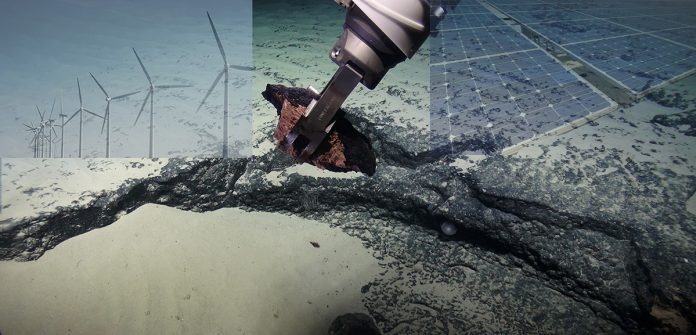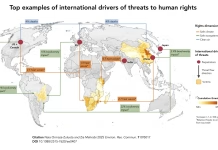Professor Bramley J Murton, Associate Head of Marine Geosciences from National Oceanography Centre, discusses if deep-sea minerals can meet the zero-carbon challenge, in this article
It is clear the world is facing a shortfall in the supply of critical elements to reach any meaningful target for net-zero carbon emissions this century. However, the deep ocean floor hosts billions of tonnes of metalliferous mineral deposits that may hold the solution.
With the recognition and acceptance that fossil carbon-based fuels are environmentally unsustainable sources of energy, causing uncontrolled and adverse effects on the global climate, the world is demanding their replacement with renewable energy sources to achieve a zero-carbon future for humankind in the second half of the 21st Century [1].
The ambition to replace fossil carbon-based energy sources with renewables will be accompanied by a huge increase in demand for metals like copper, nickel, zinc, and elements critical to enabling renewable energy generation.
Many of these elements are relatively scarce or restricted to very few areas of the globe and include: cobalt and lithium (used in batteries for electric vehicles); tellurium (used in cadmium-telluride thin-film, photovoltaic electrical energy generation); neodymium and dysprosium (used for permanent magnets in wind-turbines and electric motors); heavy rare earth elements (used in electronics), and platinum group elements (used in fuel cells and hydrogen catalysers).
This demand is illustrated by the resources needed to electrify the world’s estimated 2 billion private cars. Compared with today’s global metal production [2], the best-case scenario requires 126 years’ of cobalt, 62 years’ of neodymium, 45 years’ of lithium, and 31 years’ of copper. To power these by wind turbines requires 20 years of neodymium and dysprosium [3] or, using CdTe-type photovoltaic solar energy [4], 2000 years’ of tellurium supply.
Potential
Deep-sea minerals are rich in these critical elements. There are three main types of deposit. Ferromanganese nodules are iron-manganese oxide-oxyhydroxide concretions, rich in nickel, copper, titanium, cobalt and heavy rare earth elements, and are found on the deep ocean floor between 4,000-6,500 m. The best known is the Clarion-Clipperton Zone (CCZ), between the west coast of Mexico and Hawaii, and has about 21-30 billion tonnes. The Peru Basin has about ~6-9 billion tonnes while the Penrhyn Basin, located near the Cook Islands, has an estimated 5-7 billion tonnes of nodules with a resource potential of ~21 million tonnes of cobalt (i.e. 210 years’ worth of global land-based production).
In the Indian ocean, nodule fields are less valuable, containing low average abundances ~5 kg/m2. Worldwide, ferromanganese nodules present an enormous source of metals, with 10 times more manganese, 6 times more cobalt, 4 times more tellurium and yttrium, 3.5 times more nickel, and a third more copper compared with land-based reserves [5].
Cobalt-rich crusts are another type of iron-manganese oxide-oxyhydroxides accretion, up to 25 cm thick, formed on rocky substrates such as seamounts and underwater ridges. They are rich in cobalt (0.5-1.2%) and other critical elements such as tellurium, platinum, rare earths, titanium, thallium and nickel [6]. These crusts occur throughout the global ocean, at all depths below 700 m, but are thickest on the oldest areas such as the prime crust zone of the northwest Pacific. They contain more than half the nickel, a fifth of the titanium, over 3 times the yttrium (and other rare earth elements), 7 times the cobalt, 23 times the tellurium, and 3000 times the thallium compared with land-based reserves [5].
Seafloor massive sulphides and their metalliferous sediments are the product of intense seafloor volcanic activity and form rapidly from high-temperature (up to 415°C) hydrothermal fluids (black-smokers). They form 100-300 m diameter deposits, on and below the seafloor, at depths from 1000 to 5000 m, in all oceans. They are primarily rich in iron (up to 32%), zinc (up to 17%), copper (up to 13%), gold (up to 13 ppm), silver (up to 2000 ppm) and have elevated concentrations of selenium, cobalt, bismuth, cadmium, gallium, germanium, antimony, tellurium, thallium and indium [7].
While current estimates suggest about 600 million tonnes of accessible seafloor massive sulphide [8], hydrothermally inactive deposits may be 10 times more abundant than active ones with between 3 and 5 times more sulphide under the seafloor than above it [9], hosting 20 to 30 billion tonnes of ore worldwide.
Challenges
There are three major challenges facing the nascent deep-sea mining industry. First is the uncertainty around the regulations that the United Nations International Seabed Authority is drafting, and due in 2020. Second, there remains considerable technological challenge to deep-sea mineral exploration and mining, thousands of metres below the surface and thousands of kilometres offshore. Thirdly, protecting the environment is key to gaining social license, for which much needs to be done to identify potential harm and how to mitigate it.
Future options
Although ferromanganese nodules receive the greatest attention, cobalt-rich crusts are the most enriched, host the largest global resources of cobalt and tellurium, and are closest to land. This makes them the most viable deep-sea minerals to be exploited. There remains, however, a deep-sea resource barely mentioned, yet is truly sustainable and with the greatest potential to achieve a (net) zero-carbon future. High-temperature geothermal energy, of the type driving hydrothermal vents, has the potential to generate terawatts of unlimited power. Tapping this, using offshore oil and gas production technology, and converting it to storable, transportable fuel like hydrogen, poses an as yet unexplored and unlimited resource in renewable energy.
Without deep-sea minerals and, probably, geothermal energy, there is unlikely to be a net zero-carbon economy. This may not be a welcome message, yet, because the alternatives remain elusive, urgent research and development in this space is required now.
References
[1] The Paris Agreement: https://unfccc.int
[2] McKinsey & Co, Lithium and cobalt – a tale of two commodities, Metals and Mining, June 2018: https://www.mckinsey.com
[3] Ayman Elshkaki and T.E. Graedel, Dysprosium, the balance problem, and wind power technology, Applied Energy, 136, 548-559, 2014
[4] Sarah M. Hayes, Erin A. McCullough, Critical minerals: A review of elemental trends in comprehensive criticality studies,
Resources Policy, 59, 192-199, 2018.
[5] WOR 3 Marine Resources – Opportunities and Risks. World Ocean Review, 2014
[6] Paul A. J. Lusty, James R. Hein, and Pierre Josso, Formation and Occurrence of Ferromanganese Crusts: Earth’s Storehouse for Critical Metals, Elements, 14, 313-318, 2018
[7] Sven Petersen, Berit Lehrmann, and Bramley J. Murton, Modern Seafloor Hydrothermal Systems: New Perspectives on Ancient Ore-Forming Processes, Elements, 14, 307-312, 2018
*Please note: This is a commercial profile











